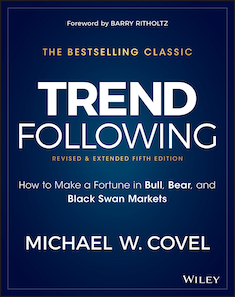 I have just finished the book, Trend Following, 5th Edition (2017): How to Make a Fortune in Bull, Bear and Black Swan Markets by Michael W. Covel. I think the first edition came out somewhere around 2004 but has been revised and extended again now with up-to-date content.
I have just finished the book, Trend Following, 5th Edition (2017): How to Make a Fortune in Bull, Bear and Black Swan Markets by Michael W. Covel. I think the first edition came out somewhere around 2004 but has been revised and extended again now with up-to-date content.
First, I want to say I started out as a counter-trend trader in early 2018 and to a great extent I still am. “Buy low, sell high” has always made sense to me as I look at the price action swinging up and down on a chart; I feel comfortable being a contrarian where masses panic or become euphoric. Trend traders look for breakouts and are not looking to buy low or short high, they go more with “buy high, sell higher” and “short low, cover lower” types of philosophy. The key difference to me in following the trend vs. going contrary: as a trend follower I buy strength and sell weakness; as a contrarian I buy weakness and sell strength. Since my counter-trend trades have a set target, I like trend following positions to let profits run without limiting the potential return. The two styles complement each other in the ever changing markets.
The book Trend Following by Michael Covel takes a deep dive into the behavior of trending markets. He has included many white papers and enough research to prove his point. Some of the data he presents goes back 800 years; of course there is not that much information about all markets but he has done a good job getting as much information as possible. The opposite to trend following in his work is the “buy and hold” style which he doesn’t trust as much as riding with trends. There’s probably different research available and anyone can find confirmation to their biases, but in this book the author shows well how trend following has outperformed the “buy and hold” through history.
Covel brings out the work of some of the best trend followers: David Harding, Ed Seykota, Bill Dunn, Keith Campbell, Jerry Parker, Richard Dennis, John W. Henry, Salem Abraham. The author compares returns of hedge funds run by these people to market benchmarks and finds out that the funds were often doing exceptionally well at times when some big market fell a lot. Supposedly the reason lies in following the trend, whether up or down. On the flip side, trend following can have large drawdowns in times with no trends and sideway markets. Then there are whipsaws and lots of small losses that can add up.
Some good points made in the book:
- It doesn’t matter what you think; it’s what the market does that matters. Your work is to catch a trend and manage risk.
- Trend followers catch the biggest booms and busts cause they just get on the trend and ride with it. When wrong, they cut losses, no questions asked.
- Trend following strategies can be robust and simple, yet profitable. Purely mechanical and price-based logic applied to different markets.
- Riding with a trend needs very little maintenance. It works cause you’re not trying to outthink it.
- One needs to deal with large drawdowns in sideway markets and keep following the system to catch upcoming trends.
- Don’t limit to only a few markets cause you never know where the next trend starts.
Few things I have understood to look out for when trying to come up with a trend following strategy. First, the longer term your position, the less important is where you enter. Amateurs want to time the entry but it’s the exit that’s more important and determines the outcome of your trade. Secondly, you want to diversify your business across different markets (equities, bonds, forex, commodities and even crypto) but also use different styles (long and short), timeframes etc. The trading strategy itself can be very simple, for example use a moving average to determine the direction and scope of a trend. While trend lines are subjective to how you draw them on a chart, moving average is an indicator based on mathematical formula.
To catch a trend you need to be in the market. The question is about whipsaw vs. lag. If you jump in early you need to deal with whipsaws and be stopped out possibly few times before the trend starts; if you wait for confirmation you will be in late and miss part of the move (lag). One needs to find balance between the two.
I recommend this book not only to trend traders but also to investors looking to take advantage of trends in their investments whatever the markets may be.
Trend Following by Michael W. Covel book link
Share this post